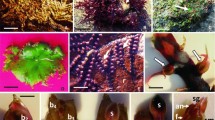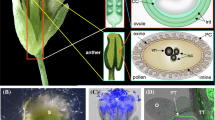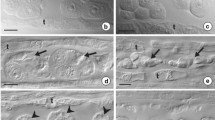Summary
Fertilization inEphedra trifurca was examined with a combination of light and fluorescence microscopy. Developmental analysis clearly indicates that double fertilization events, similar to those described inE. nevadensis, regularly occur during the process of sexual reproduction inE. trifurca. In addition to the typical fusion of a sperm nucleus and egg nucleus, a second fertilization event occurs between the second sperm nucleus from an individual pollen tube and the ventral canal nucleus. Both of the fertilization events take place within the confines of an individual egg cell of the female gametophyte. Microspectrofluorometric data demonstrate that each nucleus involved in a sexual fusion event proceeds through the synthesis phase of the cell cycle and increases its DNA content from 1C to 2C before the process of nuclear fusion is completed. Photometric data also confirm that the product of the second fertilization event is equal in DNA content (4C) to the zygotic nucleus derived from the first fertilization event, and is prepared to enter into mitosis as a fully functional diploid nucleus.
Similar content being viewed by others
Abbreviations
- DAPI:
-
4′;,6-diamidino-2-phenylindole
- RFU:
-
relative fluorescence units
References
Biro RJ, Van Tuyl JM, De Vries JN (1990) Flow cytometric determination of relative nuclear DNA contents in bicellulate and tricellulate pollen. Ann Bot 65: 3–8
Brink RA, Cooper DC (1947) The endosperm in seed development. Bot Rev 13: 423–541
Crane PR (1985) Phylogenetic analysis of seed plants and the origin of angiosperms. Ann Missouri Bot Gard 72: 716–793
D'Amato F, Devreux M, Scarascia Mugnozza GT (1965) The DNA content of the nuclei of the pollen grains in tobacco and barley. Caryologia 18: 377–381
Donoghue MJ (1989) Phylogenies and the analysis of evolutionary sequences, with examples from seed plants. Evolution 43: 1137–1156
Doyle JA, Donoghue MJ (1986) Seed plant phylogeny and the origin of angiosperms: an experimental cladistic approach. Bot Rev 52: 321–431
Ermakov IP, Morozova EM, Karpova LV (1980) DNA content in nuclei of male gametophytes of some flowering plants. Dokl Bot Sci 251: 32–33
Friedman WE (1987) Growth and development of the male gametophyte ofGinkgo biloba (in vivo). Amer J Bot 74: 1797–1815
Friedman WE (1990 a) Double ferilization inEphedra, a nonflowering seed plant: its bearing on the origin of angiosperms. Science 247: 951–954
— (1990 b) Sexual reproduction inEphedra nevadensis (Ephedraceae): further evidence of double fertilization in a nonflowering seed plant. Amer J Bot 77: 1582–1598
Gerassimova-Navashina H (1957) On some cytological principles underlying double fertilization. Phytomorphology 7: 150–167
— (1960) A contribution to the cytology of fertilization in flowering plants. Nucleus 3: 111–120
— (1961) Fertilization and events leading up to fertilization and their bearing on the origin of angiosperms. Phytomorphology 11: 139–146
— (1969) Some cytological aspects of double fertilization. Rev Cytol Biol Vég 32: 301–308
Guignard L (1899) Sur les anthérozoides et la double copulation sexuelle chez les végétaux angiosperms. Compt Rend Acad Sci Paris 128: 864–871
Haig D (1990) New perspectives on the angiosperm female gametophyte. Bot Rev 56: 236–274
Herzfeld S (1922)Ephedra campylopoda Mey. Morphologie der weiblichen Blüte und Befruchtungsvorgang. Denkschr Akad Wiss Wien Math-Naturwiss Kl 98: 243–268
Hesemann CU (1973) Untersuchungen zur Pollenentwicklung und Pollenschlauchbildung bei höheren Pflanzen. Theor Appl Genet 43: 232–241
Khan R (1940) A note on “double fertilization” inEphedra foliata. Curr Sci 9: 323–234
— (1943) Contributions to the morphology ofEphedra foliata Boiss. II. Fertilization and embryogeny. Proc Nat Acad Sci India 13: 357–375
Land WJG (1907) Fertilization and embryogeny inEphedra trifurca. Bot Gaz 44: 273–292
Moss GI, Heslop-Harrison J (1967) A cytochemical study of DNA, RNA, and protein in the developing maize anther. Ann Bot NS 31: 555–572
Moussel B (1977) Structures protoplasmiques au sein de la cavité archégoniale et modalités de la proembryogénèse chez l'Ephedra distachya L. Rev. Cytol Biol Vég 40: 73–123
— (1978) Double fertilization in the genusEphedra, Phytomorphology 28: 336–345
— (1983) Spermatogenèse chez l'Ephedra distachya L. Étude ultrastructurale de la germination du grain de pollen et du tube pollinique au sein de l'ovule. Rev Cytol Biol Vég Bot 6: 279–304
Navashin SG (1898) Resultate einer Revision der Befruchtungsvorgänge beiLilium martagon undFritillaria tenella. Bull Acad Sci Saint Petersbourg 9/4
Woodard JW (1956) DNA in gametogenesis and embryogeny inTradescantia. J Biophys Biochem Cytol 2: 765–776
Author information
Authors and Affiliations
Rights and permissions
About this article
Cite this article
Friedman, W.E. Double fertilization inEphedra trifurca, a non-flowering seed plant: The relationship between fertilization events and the cell cycle. Protoplasma 165, 106–120 (1991). https://doi.org/10.1007/BF01322281
Received:
Accepted:
Issue Date:
DOI: https://doi.org/10.1007/BF01322281




